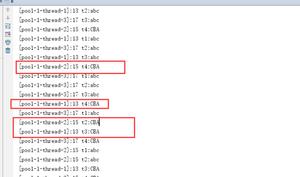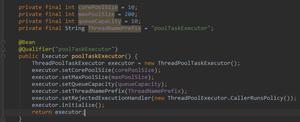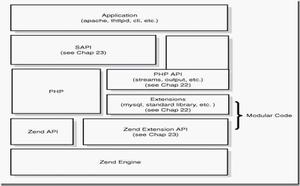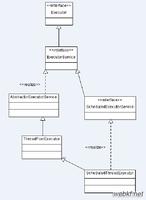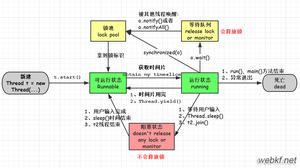阻塞队列的应用之线程池
线程池基本概念
概念:线程池主要是控制运行线程的数量,将待处理任务放到等待队列,然后创建线程执行这些任务。如果超过了最大线程数,则等待。
优点:
- 1.线程复用:不用一直new新线程,重复利用已经创建的线程来降低线程的创建和销毁开销,节省系统资源。
- 2.提高响应速度:当任务达到时,不用创建新的线程,直接利用线程池的线程。
- 3.管理线程:可以控制最大并发数,控制线程的创建等。
体系:
Executor→ExecutorService→AbstractExecutorService→ThreadPoolExecutor。ThreadPoolExecutor是线程池创建的核心类。类似Arrays、Collections工具类,Executor也有自己的工具类Executors。
线程池三种常用创建方式
newFixedThreadPool:使用LinkedBlockingQueue实现,定长线程池。
public static ExecutorService newFixedThreadPool(int nThreads) {return new ThreadPoolExecutor(nThreads, nThreads,
0L, TimeUnit.MILLISECONDS,
new LinkedBlockingQueue<Runnable>());
}
newSingleThreadExecutor:使用LinkedBlockingQueue实现,一池只有一个线程。
public static ExecutorService newSingleThreadExecutor() {return new FinalizableDelegatedExecutorService(new ThreadPoolExecutor(1, 1,
0L, TimeUnit.MILLISECONDS,
new LinkedBlockingQueue<Runnable>()));
}
newCachedThreadPool:使用SynchronousQueue实现,变长线程池。
public static ExecutorService newCachedThreadPool() {return new ThreadPoolExecutor(0, Integer.MAX_VALUE,
60L, TimeUnit.SECONDS,
new SynchronousQueue<Runnable>());
}
线程池创建的七个参数
- 1.
corePoolSize:线程池常驻核心线程数 - 2.
maximumPoolSize:能够容纳的最大线程数 - 3.
keepAliveTime:空闲线程存活时间 - 4.
unit:存活时间单位 - 5.
workQueue:存放提交但未执行任务的队列 - 6.
threadFactory:创建线程的工厂类 - 7.
handler:等待队列满后的拒绝策略
理解:线程池的创建参数,就像一个银行。
corePoolSize就像银行的“当值窗口“,比如今天有2位柜员在受理客户请求(任务)。如果超过2个客户,那么新的客户就会在等候区(等待队列workQueue)等待。当等候区也满了,这个时候就要开启“加班窗口”,让其它3位柜员来加班,此时达到最大窗口maximumPoolSize,为5个。如果开启了所有窗口,等候区依然满员,此时就应该启动”拒绝策略“handler,告诉不断涌入的客户,叫他们不要进入,已经爆满了。由于不再涌入新客户,办完事的客户增多,窗口开始空闲,这个时候就通过keepAlivetTime将多余的3个”加班窗口“取消,恢复到2个”当值窗口“。
线程池的底层原理
原理图:上面银行的例子,实际上就是线程池的工作原理。

流程图:
新任务到达→
如果正在运行的线程数小于corePoolSize,创建核心线程;大于等于corePoolSize,放入等待队列。
如果等待队列已满,但正在运行的线程数小于maximumPoolSize,创建非核心线程;大于等于maximumPoolSize,启动拒绝策略。
当一个线程无事可做一段时间keepAliveTime后,如果正在运行的线程数大于corePoolSize,则关闭非核心线程。
线程池的拒绝策略
当等待队列满时,且达到最大线程数,再有新任务到来,就需要启动拒绝策略。JDK提供了四种拒绝策略,分别是。
- 1.AbortPolicy:默认的策略,直接抛出RejectedExecutionException异常,阻止系统正常运行。
- 2.CallerRunsPolicy:既不会抛出异常,也不会终止任务,而是将任务返回给调用者。
- 3.DiscardOldestPolicy:抛弃队列中等待最久的任务,然后把当前任务加入队列中尝试再次提交任务。
- 4.DiscardPolicy:直接丢弃任务,不做任何处理。
实际生产使用哪一个线程池?
单一、可变、定长都不用!原因就是FixedThreadPool和SingleThreadExecutor底层都是用LinkedBlockingQueue实现的,这个队列最大长度为Integer.MAX_VALUE,显然会导致OOM。所以实际生产一般自己通过ThreadPoolExecutor的7个参数,自定义线程池。
ExecutorService threadPool=new ThreadPoolExecutor(2,5,1L,TimeUnit.SECONDS,
new LinkedBlockingQueue<>(3),
Executors.defaultThreadFactory(),
new ThreadPoolExecutor.AbortPolicy());
public class MyThreadPoolDemo {public static void main(String[] args) {
System.out.println("Fixed Thread Pool");
fixedThreadPool();
System.out.println("Single Thread Pool");
singleThreadPool();
System.out.println("Cached Thread Pool");
cachedThreadPool();
System.out.println("Custom Thread Pool");
customThreadPool();
}
private static void customThreadPool() {
ExecutorService threadPool=
new ThreadPoolExecutor(2,
5,
1L,
TimeUnit.SECONDS,
new LinkedBlockingQueue<>(3),
Executors.defaultThreadFactory(),
new ThreadPoolExecutor.AbortPolicy()
);
try {
for (int i = 0; i < 9; i++) {
threadPool.execute(() -> {
System.out.println(Thread.currentThread().getName()+"t办理业务");
});
}
} catch (Exception e) {
e.printStackTrace();
} finally {
threadPool.shutdown();
}
}
private static void cachedThreadPool() {
//不定量线程
ExecutorService threadPool = Executors.newCachedThreadPool();
try {
for (int i = 0; i < 9; i++) {
threadPool.execute(() -> {
System.out.println(Thread.currentThread().getName()+"t办理业务");
});
}
} catch (Exception e) {
e.printStackTrace();
} finally {
threadPool.shutdown();
}
}
private static void singleThreadPool() {
//一池1个线程
ExecutorService threadPool = Executors.newSingleThreadExecutor();
try {
for (int i = 0; i < 9; i++) {
threadPool.execute(() -> {
System.out.println(Thread.currentThread().getName() + "t办理业务");
});
}
} catch (Exception e) {
e.printStackTrace();
} finally {
threadPool.shutdown();
}
}
private static void fixedThreadPool() {
//一池5个线程
ExecutorService threadPool = Executors.newFixedThreadPool(5);
//一般常用try-catch-finally
//模拟10个用户来办理业务,每个用户就是一个线程
try {
for (int i = 0; i < 9; i++) {
threadPool.execute(() -> {
System.out.println(Thread.currentThread().getName() + "t办理业务");
});
}
} catch (Exception e) {
e.printStackTrace();
} finally {
threadPool.shutdown();
}
}
}
自定义线程池参数选择
对于CPU密集型任务,最大线程数是CPU线程数+1。对于IO密集型任务,尽量多配点,可以是CPU线程数*2,或者CPU线程数/(1-阻塞系数)。
死锁编码和定位
public class DeadLockDemo {//两个锁对象
private static Object obj1 = new Object();
private static Object obj2 = new Object();
public static void main(String[] args) {
new Thread(() -> {
while (true) {
synchronized (obj1) {
System.out.println(Thread.currentThread().getName() + "获得obj1锁");
try {
//睡3秒让另一个线程先获得obj2锁
TimeUnit.SECONDS.sleep(3);
//此时另一个线程已经持有obj2锁,这里请求获取obj2锁就会发生死锁
synchronized (obj2) {
System.out.println(Thread.currentThread().getName() + "获得obj2锁");
}
} catch (InterruptedException e) {
e.printStackTrace();
}
}
}
}).start();
new Thread(() -> {
while (true) {
synchronized (obj2) {
System.out.println(Thread.currentThread().getName() + "获得obj2锁");
try {
//睡3秒让另一个线程先获得obj1锁
TimeUnit.SECONDS.sleep(3);
synchronized (obj1) {
System.out.println(Thread.currentThread().getName() + "获得obj1锁");
}
} catch (InterruptedException e) {
e.printStackTrace();
}
}
}
}).start();
}
}
主要是两个命令配合起来使用,定位死锁。
jps指令:jps -l可以查看运行的Java进程。
jstack指令:jstack pid可以查看某个Java进程的堆栈信息,同时分析出死锁。
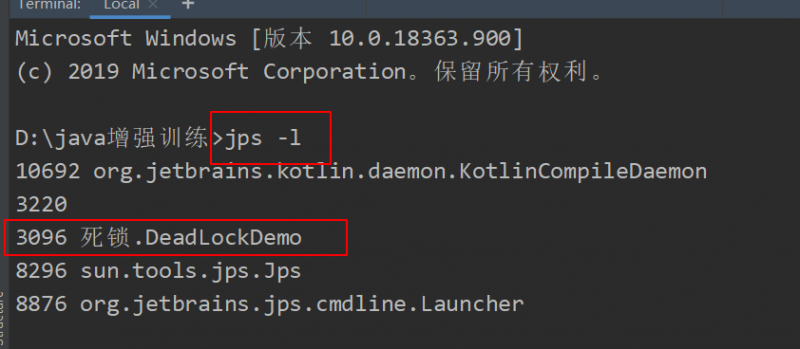
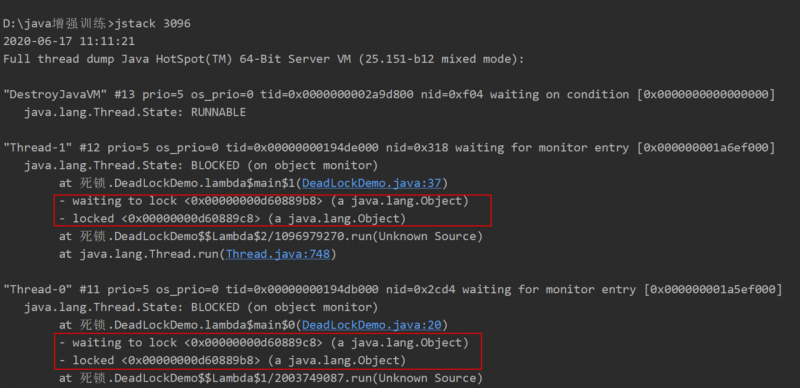
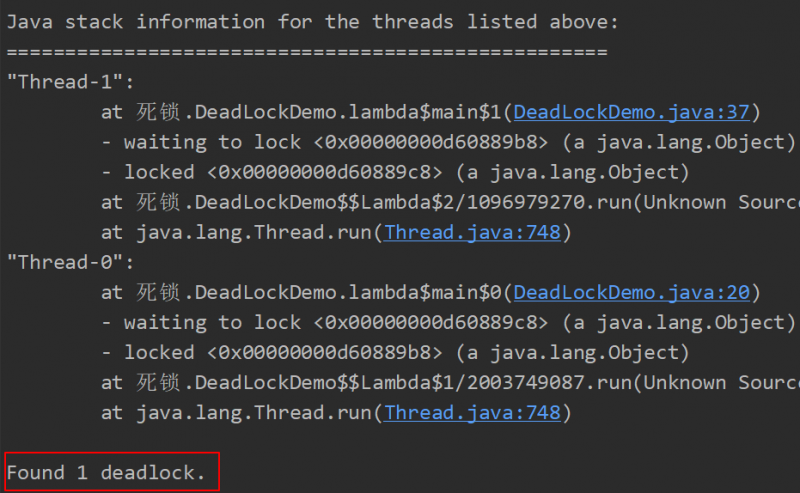
以上是 阻塞队列的应用之线程池 的全部内容, 来源链接: utcz.com/a/25400.html

